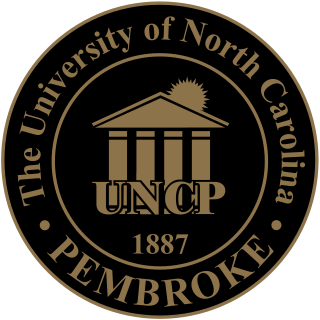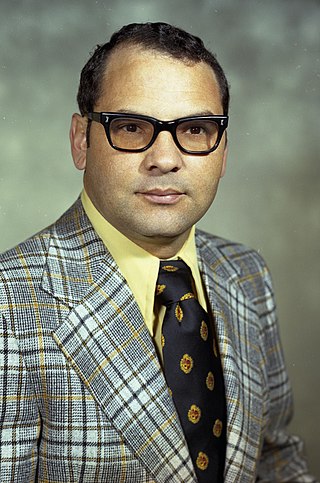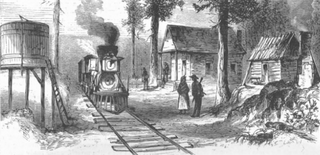
Robeson County is a county in the southern part of the U.S. state of North Carolina and is its largest county by land area. Its county seat and largest community is Lumberton. The county was formed in 1787 from part of Bladen County and named in honor of Thomas Robeson, a colonel who had led Patriot forces in the area during the Revolutionary War. As of the 2020 census, the county's population was 116,530. It is a majority-minority county; its residents are approximately 38 percent Native American, 22 percent white, 22 percent black, and 10 percent Hispanic. It is included in the Fayetteville-Lumberton-Pinehurst, NC Combined Statistical Area. The state-recognized Lumbee Tribe of North Carolina is headquartered in Pembroke.

Pembroke is a town in Robeson County, North Carolina, United States. It is about 90 miles inland and northwest from the Atlantic Coast. The population was 2,973, at the 2010 census. The town is the seat of the state-recognized Lumbee tribe of North Carolina, as well as the home of The University of North Carolina at Pembroke.
Prospect is a census-designated place (CDP) in Robeson County, North Carolina, United States. The population was 690 at the 2000 census. Located due northeast of Pembroke, Prospect is a traditionally Methodist community, with its church members largely becoming representatives for the entirety of the American Indian-Methodist community. Prospect is noted for one of its native sons, Adolph Dial, whose contributions to American Indian Studies have led to an heightened awareness of the local Lumbee Tribe and Native Americans throughout the Southeastern United States.

The University of North Carolina at Pembroke is a public university in Pembroke, North Carolina. UNC Pembroke is a master's level degree-granting university and part of the University of North Carolina system. Its history is intertwined with that of the Lumbee nation.
The Lumbee are a Native American people primarily centered in Robeson, Hoke, Cumberland, and Scotland counties in North Carolina.

The Battle of Hayes Pond, also known as the Battle of Maxton Field or the Maxton Riot, was an armed confrontation between members of a Ku Klux Klan (KKK) organization and Lumbee people at a Klan rally near Maxton, North Carolina, on the night of January 18, 1958. The clash resulted in the disruption of the rally and a significant amount of media coverage praising the Lumbees and condemning the Klansmen.

The Lowry War or Lowrie War was a conflict that took place in and around Robeson County, North Carolina, United States from 1864 to 1874 between a group of mostly Native American outlaws and civil local, state, and federal authorities. The conflict is named for Henry Berry Lowry, a Lumbee who led a gang of Native American, white and black men which robbed area farms and killed public officials who pursued them.

Julian Thomas Pierce was an American lawyer and Lumbee activist. Born in Hoke County, North Carolina, he became the first person in his family to go to college and worked for several years as a chemist at shipyards in Virginia before obtaining his law degree. Following two years of work for the U.S. Securities and Exchange Commission, he moved to Robeson County, North Carolina to direct a legal aid organization and in that capacity co-authored a petition to the federal government asking for the extension of federal recognition to the Lumbee tribe. In 1988 he resigned from his job to pursue a candidacy for a new Superior Court judgeship. Running against the local district attorney and over the objections of the county sheriff, he was found murdered in his home several weeks before the primary election. While his murder was officially determined to be the result of an interpersonal dispute, the circumstances of his death remain unclear, with his friends and family having advanced suspicions that he was assassinated for political reasons.

The Lumbee Tribe of North Carolina is a state-recognized tribe in North Carolina. The tribe represents Lumbee people. They do not hold federal recognition as a Native American tribe.
The Lumbee Regional Development Association (LRDA) is a nonprofit corporation, chartered by the State of North Carolina in 1968, organized to analyze and develop solutions for the health, educational, economic, and general welfare problems of rural and urban Indians in and around Robeson County. Its effective domain includes, but is not limited to, the Counties of Robeson, Hoke, Scotland, and Bladen, i.e., North Carolina’s Planning Region N. Federally funded programs are currently administered by the Lumbee citizens of these neighboring counties, from the LRDA offices in Pembroke, North Carolina. LRDA currently serves over 20,600 people each year. In July 2009, it had 62 full-time employees.
Adolph Lorenz Dial was an American historian, professor of history at the University of North Carolina at Pembroke, and a specialist in American Indian Studies. Dial was a member of the Lumbee Tribe and a graduate of Pembroke State College, where he obtained a bachelor's degree in social studies. Soon after graduating, Dial enlisted with the United States Army, completing a tour of duty in the European theater of World War II. Post-military, Dial obtained his master's degree and an advanced certificate in social studies from Boston University. Hired by Pembroke State College in 1958, Dial would go on to create the college's American Indian Studies program, the first of its kind at any university in the Southeast. In addition to his role in academia, Dial was a member of the North Carolina House of Representatives for a single term. Over the course of his career, Dial devoted the majority of his academic work towards enriching and publicizing the history of the Lumbee Tribe and its importance within the history of North Carolina, and within the greater narrative of Native American peoples. Dial died on December 24, 1995, 12 days after his 73rd birthday.
Ruth Dial Woods was an American educator and activist. A member of the Lumbee Tribe of North Carolina, she was the first woman to serve as the associate superintendent of the Robeson County Public Schools and to receive an at-large appointment to the University of North Carolina Board of Governors. After teaching in the public school system of Robeson County for 27 years, she joined the faculty at Fayetteville State University. In addition to her work as an educator, Woods was involved in the Civil Rights Movement, the Women's liberation movement, and the American Indian Movement. She has served as a community development consultant for the United States Department of Labor and as a consultant for the Lumbee Tribal Council for administration of tribal programs. The recipient of numerous awards and honors for her work in human rights and education, in 2011, she was inducted into the North Carolina Women's Hall of Fame.

Henry Ward Oxendine was an American lawyer and politician who served as a member of the North Carolina House of Representatives for the 21st District from 1973 to 1976. A member of the Lumbee tribe, he was the first Native American to serve in the North Carolina General Assembly.
Walter Hubert Stone was an American law enforcement officer who served as the Sheriff of Robeson County, North Carolina from 1978 to December 1994. Stone was raised in Robeson County, and in 1953 became a municipal police officer. He served as police chief of Fair Bluff from 1954 to 1957, when he was hired as a county sheriff's deputy. He was promoted to the job of detective before being elected Sheriff of Robeson County in 1978. He restructured the organization of the sheriff's department, assigning sergeants and detectives to districts in the county. During his tenure the county experience a significant level of drug trafficking, and he oversaw the doubling in size of his office's drug enforcement division and worked closely with District Attorney Joe Freeman Britt to prosecute narcotics-related offenses. A Democrat, he became a leading figure in local politics and was often sought by candidates for his support.
Glenn Allen Maynor is an American retired law enforcement officer and politician who served as Sheriff of Robeson County, North Carolina from 1994 until 2004.
On February 1, 1988, two armed Tuscarora men, Eddie Hatcher and Timothy Jacobs, took hostages in the offices of The Robesonian newspaper in Lumberton, Robeson County, North Carolina. At the time, Robeson experienced a significant level of drug trafficking and increasing public distrust of the county sheriff's office, especially from the area's significant Native American population. Hatcher believed he had evidence of corruption in the local justice system and, fearing for his life, enlisted the aid of Jacobs to try to raise awareness about his concerns. The two held the staff of the county daily newspaper hostage for 10 hours before extracting an agreement from North Carolina Governor James G. Martin to investigate corruption allegations in Robeson.

Moss Neck is a community in Robeson County, North Carolina, United States.
Pates is a community in Robeson County, North Carolina, United States.

Scuffletown was a community in Robeson County, North Carolina, United States in the 1700s and 1800s dominated by Lumbee Native Americans. The exact location of the community, the date of its creation, and the origin of its name are unclear. The community, which had no formal government, encompassed swampy territory dotted with small farms and simple cabins. Most Scuffletonians were poor and made livings by growing crops, hunting and fishing, picking berries, or performing labor for neighboring farmers.












